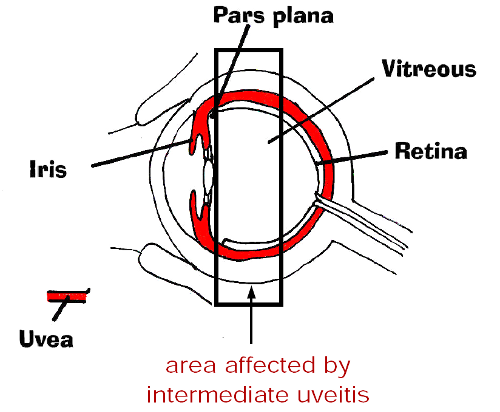What is Intermediate Uveitis?
What is Intermediate Uveitis? Uveitis is an inflammation of the inside of the eye, specifically the layer of the eye called the uvea. (See What is Uveitis?). The term, "intermediate uveitis" is used to describe the location of the inflammation in the eye. The part of the eye affected is the peripheral part of the inner eye in between the posterior and anterior parts (see Diagram below) The older terms "pars planitis" and "cyclitis" are often used to describe this type of uveitis. It must be pointed out that there are other ways to put uveitis into "groups", e.g. infectious or non-infectious and chronic or acute. This means that there are usually no "clear cut" or "typical" cases of intermediate uveitis. Unfortunately uveitis may often give rise to a complicated picture but here, the term intermediate uveitis is used when the major part of the inflammation affects the area of the eye shown below.
Intermediate uveitis typically affects teenagers but can occur in very young children. The over 40's are not often affected. This pattern differs from most other forms of uveitis.
Symptoms
This is generally not a painful condition and there is not usually any redness in the eyes, (unlike anterior uveitis). Typically there is blurring and/or the presence of floaters, (black dots or wispy lines that move across the field of vision). Both eyes are usually affected but not always at the same time and not to the same degree. The condition may be present for quite some time before it is diagnosed because the patient may not be aware of any problem The severity of the condition varies greatly. Often, the vision may not be affected at all, but there are a number of ways that vision loss can occur, or other complications may arise.Vitreous opacification is caused by "debris" resulting from the inflammation getting into the vitreous humour, the "clear jelly" which fills the eye. This produces the "floaters" which can be just irritating but which don't affect the vision as measured by an eye chart . If it is more severe, then the vision may be obscured.
Macular oedema. The macula is the tiny part of the retina, which is responsible for our central or detailed vision. Fluid can build up in the macula and cause very specific problems with the vision If our central vision is affected in this way then reading, recognising people's faces and reading notices etc. will be difficult. If severe, then straight lines such as white lines along a road may appear distorted.
Anterior Uveitis. Some people with intermediate uveitis also get the anterior type (also known as iritis). Things are often not simple with uveitis and these other complications can confuse the overall picture. The main thing to note if anterior uveitis occurs is that there may be pain and a red eye.
There are some complications which can arise with any form of uveitis. These include cataracts, and raised eye pressure, leading to glaucoma. There is additional information on these complications from the group. Please contact us for more help.
Causes
Often, like other types of uveitis, the cause is unknown. As there may be associations with other diseases such as sarcoidosis then there will always be a thorough general investigation carried out.How long will the condition last?
This is an important question but it may also be a very frustrating one to deal with for both patient and doctor. Particularly with the younger age groups there is always the question of whether this is something that will be "grown out" of or will "burn out". This may well be the case eventually but it is possible that the condition may be around for several years. The condition also varies in its severity enormously and can be quite unpredictable in its course. The main aim of the treatment is to thoroughly treat and monitor the inflammation so that it causes no or minimal damage to the eyes before the condition hopefully "burns out".Treatment (if required)
- Treatment of any associated disease eg sarcoidosis.
- Use of steroids as tablets or just possibly as injections around the eye which are done in the eye clinic (these are carried out after discussion with your doctors under local anaesthetic or, often, with younger patients under a general anaesthetic).
- Cyclosporin often used in combination with steroids to reduce the dosage of steroids or if side effects are a problem.

